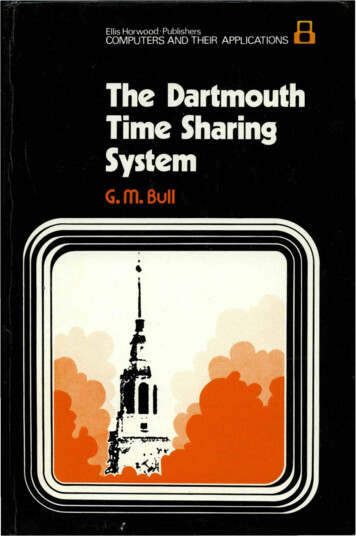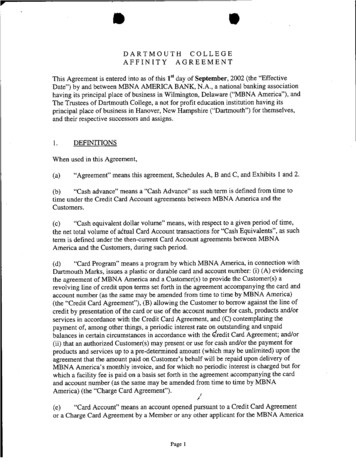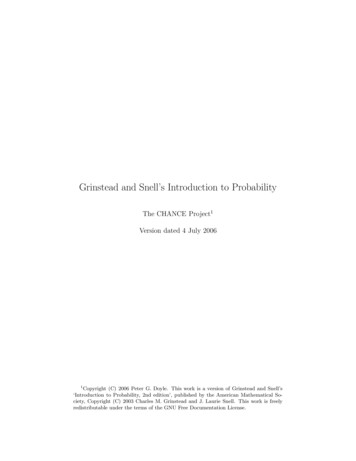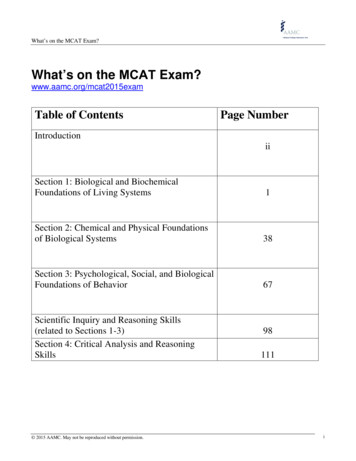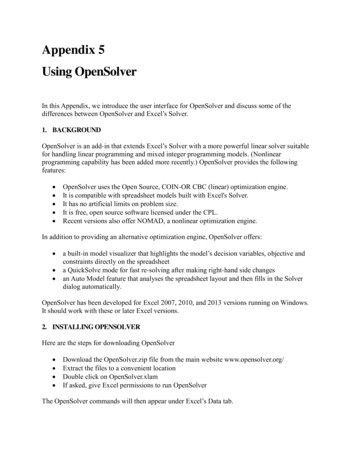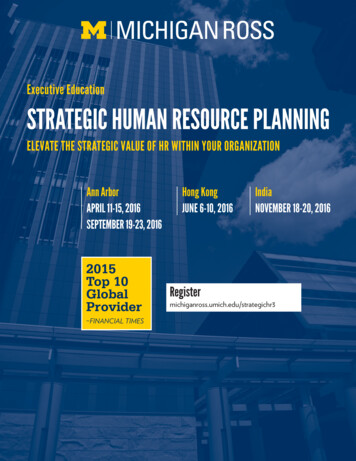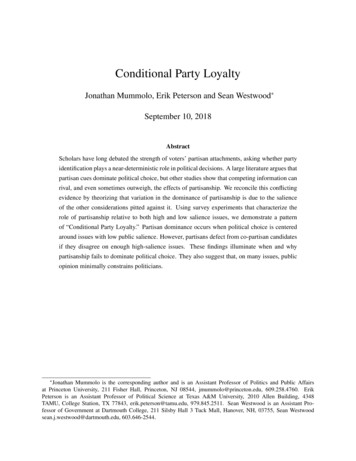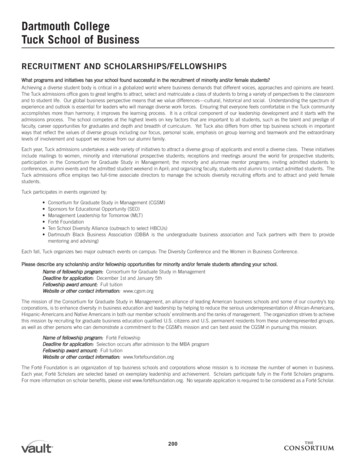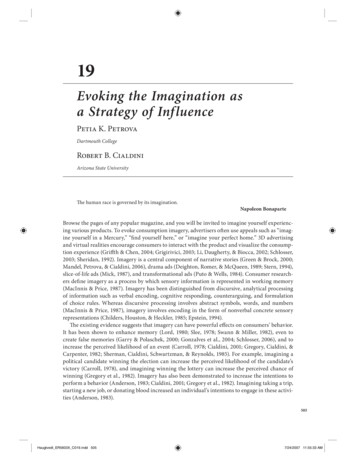
Transcription
19Evoking the Imagination asa Strategy of InfluencePetia K. PetrovaDartmouth CollegeRobert B. CialdiniArizona State UniversityThe human race is governed by its imagination.Napoleon BonaparteBrowse the pages of any popular magazine, and you will be invited to imagine yourself experiencing various products. To evoke consumption imagery, advertisers often use appeals such as “imagine yourself in a Mercury,” “find yourself here,” or “imagine your perfect home.” 3D advertisingand virtual realities encourage consumers to interact with the product and visualize the consumption experience (Grifft h & Chen, 2004; Grigirivici, 2003; Li, Daugherty, & Biocca, 2002; Schlosser,2003; Sheridan, 1992). Imagery is a central component of narrative stories (Green & Brock, 2000;Mandel, Petrova, & Cialdini, 2006), drama ads (Deighton, Romer, & McQueen, 1989; Stern, 1994),slice-of-life ads (Mick, 1987), and transformational ads (Puto & Wells, 1984). Consumer researchers define imagery as a process by which sensory information is represented in working memory(MacInnis & Price, 1987). Imagery has been distinguished from discursive, analytical processingof information such as verbal encoding, cognitive responding, counterarguing, and formulationof choice rules. Whereas discursive processing involves abstract symbols, words, and numbers(MacInnis & Price, 1987), imagery involves encoding in the form of nonverbal concrete sensoryrepresentations (Childers, Houston, & Heckler, 1985; Epstein, 1994).The existing evidence suggests that imagery can have powerful effects on consumers’ behavior.It has been shown to enhance memory (Lord, 1980; Slee, 1978; Swann & Miller, 1982), even tocreate false memories (Garry & Polaschek, 2000; Gonzalves et al., 2004; Schlosser, 2006), and toincrease the perceived likelihood of an event (Carroll, 1978; Cialdini, 2001; Gregory, Cialdini, &Carpenter, 1982; Sherman, Cialdini, Schwartzman, & Reynolds, 1985). For example, imagining apolitical candidate winning the election can increase the perceived likelihood of the candidate’svictory (Carroll, 1978), and imagining winning the lottery can increase the perceived chance ofwinning (Gregory et al., 1982). Imagery has also been demonstrated to increase the intentions toperform a behavior (Anderson, 1983; Cialdini, 2001; Gregory et al., 1982). Imagining taking a trip,starting a new job, or donating blood increased an individual’s intentions to engage in these activities (Anderson, 1983).505Haugtvedt ER5603X C019.indd 5057/24/2007 11:55:33 AM
506PETIA K. PETROVA AND ROBERT B. CIALDINIOf course, of specific interest to consumer researchers are the effects of product imagery.Research in this direction reveals that instructing individuals to use their imagination while processing the product information (Keller & Block, 1997; Keller & McGill, 1994; Krishnamurthy &Sujan, 1999; McGill & Anand, 1989) or incorporating imagery appeals in an ad (Babin & Burns,1997; Bone & Ellen, 1992; Escalas, 2004) can enhance product evaluations and the likelihood ofpurchasing the product. For example, in one of the first studies on the effects of imagination in aconsumer context (Gregory et al., 1982), half of the residents in a neighborhood were given information about the features of a cable service. The other half of the residents were asked to imaginethemselves utilizing the features of the cable service. Several weeks later, representatives from thecable company solicited these residents’ orders for cable service. The results revealed that 19.5% ofthe residents who had only heard the features of the product subscribed to the service. However,among those that imagined having the cable TV service, the subscription rate was 47.4%. Simplyasking consumers to imagine having the product doubled the sales rate.Given the evidence for the effects of imagery on consumers’ judgments and behavior, it is important to understand the mechanisms through which such effects occur. Researchers have suggestedseveral mechanisms, yet how imagery changes consumers’ preferences and behavior is not fullyunderstood. Hoping to spur more research in this direction, we review the existing evidence for theprocesses underlying the effects of imagery and suggest unexplored possibilities. We also reviewvariables moderating these effects and outline conditions under which asking consumers to imagine their experience with the product can be particularly effective or, alternatively, can decreasethe likelihood of purchasing the product. Our goal is twofold: to provide an integrative view of thedifferent approaches toward the use of imagery as a strategy of influence, and to inspire new ideasin this fascinating domain of consumer psychology.PROCESSES UNDERLYING THE EFFECTS OF IMAGERYVisualizing is a way of knowing: it is a mode of generating knowledge. . . . How we see determineswhat we see; and how we see is embodied in our mental images. By virtue of their condensing impulse,images have a kind of power that abstract ideas can never have.Mervyn Nicholson, 13 Ways of Looking at ImagesTraditional ApproachesTraditional approaches in persuasion research have focused on processes such as affect, consideration of arguments, and recall. Such approaches have been applied to the effects of imagery aswell. For example, studies suggest that because of the affective responses it evokes, imagery canenhance product evaluations (Bolls, 2002; Goossens, 1994, 2000; Mani & MacInnis, 2001; Oliver,Thomas, & Mitchell, 1993; Strack, Schwarz, & Gschneidinger, 1985). Research also reveals thatinformation processed using imagery is stored in both a sensory code and a semantic code; thusimagery has multiple linkages in memory (Childers & Houston, 1984; Kieras, 1978) and is moreeasily retrieved than information stored in a semantic code only (Houston, Childers, & Heckler,1987; Pavio, 1971). Given the role of information accessibility, it has also been suggested that vividinformation or instructions to imagine the product are likely to influence product preferences byincreasing the accessibility of favorable product-related information (Kisielius & Sternthal, 1984,1986). This proposition, known as the availability-valence hypothesis, further suggests that becauseimagery can increase cognitive elaboration, it can increase or decrease product preferences according to the valence of the product information made accessible. That is, imagery can increase theHaugtvedt ER5603X C019.indd 5067/24/2007 11:55:41 AM
EVOKING THE IMAGINATION AS A STRATEGY OF INFLUENCE507accessibility of not only favorable but also unfavorable product information. In such cases, askingconsumers to imagine the product experience can decrease product preferences.Despite the evidence in support of these processes, more recent research suggests that there areadditional processes taking place when consumers imagine the product experience. For example,Mani and MacInnis (2001) and Escalas (2004) reported that imagining the consumption experience influenced consumers’ affective responses. In both studies, however, imagery had a positiveeffect on product preferences even when controlling for affect, suggesting that affect alone cannotaccount for the positive effects of the imagery on product evaluations. Furthermore, positive affectwould not account for the effects of imagery on estimates of the likelihood of negative events suchas being arrested for armed robbery (Gregory et al., 1982) or the effects of imagery on the likelihoodof performing behaviors evoking negative affect (e.g., blood donation; Anderson, 1983).Similarly, imagery appeals may engage processes that are different from those evoked by simplypresenting individuals with a pictorial product depiction. A recent set of studies revealed that,consistent with the availability-valence hypothesis, increasing the vividness of the product depiction resulted in a greater number of product-relevant thoughts and greater recall of the productinformation (Petrova & Cialdini, 2005). However, these effects were not observed with regard toimagery appeals. In fact, instructing participants to process the information using their imagination decreased product-related thoughts, thoughts about specific product attributes, and recallof the product attributes. It has also been demonstrated that imagining the process of using theproduct can make consumers less sensitive to the strength of the arguments in the ad (Escalas &Luce, 2003, 2004). Furthermore, the effects of imagery were not mediated by cognitive elaboration(Schlosser, 2003); neither were they moderated by the individuals’ dispositional tendency to spontaneously elaborate on information (measured with the Need for Cognition Scale; Cacioppo, Petty,& Kao, 1984; Green & Brock, 2000; Schlosser, 2003). According to these findings, imagery may notnecessarily increase consideration of the positive and negative features of the product and in somecases may even decrease elaboration on the message arguments. Thus, additional processes may betaking place when consumers imagine their future experience with the product. Recent investigations provide some insight into this possibility.New ApproachesTransportation and reduced counterarguing. Contemporary investigations reveal conceptuallynew processes that may be taking place when consumers engage in imagining the product experience. One such approach stems from findings in the area of narrative transportation. As researchon the persuasiveness of narratives reveals, narratives are effective in changing attitudes and beliefsbecause they transport individuals into a different reality, thus reducing consideration of the positive and negative aspects of the message (Green & Brock, 2000). The process of transportationhas been described as “immersion into a text,” and being “lost” in a story (Green & Brock, 2000,p. 702). “A person engaged in elaboration might be accessing his or her own opinions, previousknowledge, or other thoughts and experiences in order to evaluate the message at hand. Underhigh elaboration, connections are established to an individual’s other schemas and experiences.In contrast, under high transportation, the individual may be distanced temporarily from current and previous schemas and experiences” (p. 702). Imagery may influence product evaluationsthrough a similar mechanism, by transporting consumers into a distant reality and reducing theirattention to the favorability of the product information (Escalas, 2004, 2007). When individuals aretransported into an imagined world, they may not be motivated to correct for their initial beliefsand expectations, because (a) they may not believe that the imagery had an effect on them, and (b)Haugtvedt ER5603X C019.indd 5077/24/2007 11:55:41 AM
508PETIA K. PETROVA AND ROBERT B. CIALDINIinterrupting the imagery to counterargue the information can make the experience less enjoyable.Moreover, because experiencing the imagery is likely to occupy considerable mental resources,individuals may not be able to correct for the initial effects of the imagery on their evaluations.Indeed, recent research suggests that when consumers imagine their experience with the productthey are less likely to evaluate the specific product attributes and counterargue the message arguments. For example, argument strength had an impact on the evaluation of the brand when individuals were not asked to imagine their experience with the product, but it did not have an impactwhen participants engaged in imagery (Escalas, 2004, 2007). Furthermore, when the product wasdescribed in a narrative, the inclusion of undesirable product features in the presentation did notaffect product evaluations, although this information did undermine evaluations when the productfeatures were presented in a list format (Adaval & Wyer, 1998). When presented with the narrativedescription of the product, participants processed the information in a holistic manner and wereless likely to draw inferences based on the specific attributes presented in the ad. Such findingsare consistent with research examining the effects of imagery on comparative advertising, whichdemonstrates that advertisements comparing the product to its competitor are effective under analytical processing but not under imagery processing (Thompson & Hamilton, 2006). Again, thesefindings suggest that when individuals process product information using their imagination, theyare not likely to consider the positive and negative aspects of the presented information, but ratherthey adopt a more holistic approach, transporting themselves into a fictitious reality.The imagery accessibility account. Another general area of research that has spurred new investigations into the processes underlying the effects of imagery focuses on consumers’ subjectiveexperiences of fluency. A considerable amount of evidence has been accumulated to demonstratethat when forming attitudes, opinions, and judgments, individuals are likely to take into accountnot only the content of the information with which they are presented, but also the ease with whichthis information comes to mind (Schwarz, 1998, 2004). For instance, consumers may not necessarily base their product evaluations on the content of the product information with which they arepresented; they may base their evaluations instead on the fluency with which they can process thisinformation (Lee & Labroo, 2004). Furthermore, consumers often base their product preferencesnot on the number of arguments for purchasing the product that they can generate, but ratheron the subjective accessibility of these arguments (Menon & Raghubir, 2003; Wänke, Bohner, &Jurkowitsch, 1997).Based on this approach, in contrast to examining the impact of imagery on consumers’ elaboration on the message arguments, the imagery accessibility account focuses on the metacognitiveexperiences involved in processing product information using imagery. For example, when purchasing a house, consumers may consider how easily they see themselves living in this house. Typically, individuals can easily imagine having products that are suitable for them, that they intendto purchase, or that they desire; therefore, simulating the product experience can be an efficientdecision-making strategy. However, the ease with which consumers can imagine themselves withthe product can also be influenced by factors irrelevant to their intentions or the merits of theproduct. For example, when a consumer is deciding on a vacation destination, an image of a vacation in Hawaii might come to mind easily if the individual has previously been provided withimagery-evoking information in brochures or movies. Engaging consumers in product imagerythrough use of such commercial images of the consumption experience can create readily accessible mental representations of having the product and can increase the ease with which such representations will spring to mind during the decision-making process.Indeed, research suggests that we tend to use the ease with which we create a mental representation of an event to estimate the likelihood of an event (Sherman et al., 1985). Furthermore, the ease ofHaugtvedt ER5603X C019.indd 5087/24/2007 11:55:41 AM
EVOKING THE IMAGINATION AS A STRATEGY OF INFLUENCE509imagery generation has been found to influence not only the perceived likelihood of external eventsbut also product evaluations and purchase intentions (Dahl & Hoeffler, 2004; Petrova & Cialdini,2005; Zhao, Hoeffler, & Dahl, 2007). Further evidence about the role of imagery accessibility comesfrom research on the effect of hypothetical questions. As a number of studies in this area havedemonstrated, simply asking individuals about the likelihood that they will engage in a behaviorcould make them actually perform the behavior (Fitzsimons & Morwitz, 1996; Greenwald, Carnot,Beach, & Young, 1987; Morwitz, Johnson, & Schmittlein, 1993). More recent research, however,reveals that this effect is moderated by the ease with which individuals can generate a mental representation of the behavior (Levav & Fitzsimons, 2006). That is, when asked a hypothetical questionabout engaging in an activity, individuals spontaneously engage in generating a mental representation of the behavior. Subsequently, they base their intentions to actually perform the behavior onthe ease with which a mental representation of the behavior was generated.These findings suggest that when considering buying a product, individuals may spontaneouslyattempt to create a mental representation of the product experience. By increasing the accessibilityof such representations, imagery appeals can increase the likelihood of purchasing the product.Imagination-behavior link. A third source of new insight into the effects of imagination comesfrom research on automatic processes. According to the principle of ideomotor action (James, 1980),the mere act of thinking about a behavior may increase the tendency to engage in that behavior.“We may lay it down for certain that every representation of a movement awakens in some degreethe actual movement which is its object” (p. 526). According to James’s proposition, activating arepresentation of the behavior through imagining may increase the likelihood of activating thebehavior itself. Contemporary investigations provide findings consistent with this idea. Researchon the perception-behavior link suggests that the activation of a perceptual representation maylead to the corresponding behavior (Bargh, Chen, & Burrows, 1996; Bargh, Gollwitzer, Lee-Chai,Barndollar, & Trörschel, 2001; Chartrand, Maddux, & Lakin, 2005; Dijksterhuis & Van Knippenberg, 1998). Research on ironic processes has also demonstrated that under conditions of limitedattentional resources “the mere act of thinking about a behavior causes the behavior, even whenthe thought involved is meant to help prevent that behavior” (Ansfield & Wegner, 1996; Wegner,1994). Because imagery and perception involve similar mental processes (Segal & Fusella, 1970;Unnava, Agarwal, & Haugtvedt, 1996), we may expect that—by activating a mental representationof consuming the product—imagery may evoke the actual consumption.Neurophysiological research also suggests an automatic link between imagination and behavior(Decety, Jeannerod, Germain, & Pastene, 1991; Jeannerod, 1994, 1997; Paus, Petrides, Evans, &Myer, 1993; Pulvermuller, Harle, & Hummel, 2001; Rizzolatti & Arbib, 1998). A growing body offunctional imaging research suggests that imagining an action and the actual production of theaction rely upon common neural structures. For example, thinking about a word or gesture leadsto the same activation in the anterior cingulated cortex as actually uttering the word or making the gesture (Paus et al., 1993). Similarly, imagining performing actions such as finger and toeflexion and extension and simultaneous horizontal movements of the tongue activated specificsomatosensory and motor areas activated during actual motor execution that were also activatedduring actual performance of these movements (Ehrsson, Geyer, & Naito, 2003). In another study,participants were asked to perform, imagine, or prepare for specific hand movements while undergoing functional MRI scanning. The results revealed that the actual hand movements activatedcomponents of the motor system, including the primary motor and somatosensory cortex, thesupplementary motor area (SMA), the thalamus, and the cerebellum. When participants imagined these movements or prepared to perform them, the primary motor cortex, the SMA, and thethalamus were activated (Michelon, 2005). Similar results have been reported with imagining moreHaugtvedt ER5603X C019.indd 5097/24/2007 11:55:42 AM
510PETIA K. PETROVA AND ROBERT B. CIALDINIcomplex actions such as running, rowing, or weightlifting. Imagining such behaviors triggeredneurophysiological activities comparable to those generated by actually engaging in these behaviors (Decety et al., 1991; Jeannerod, 1994, 1997).These findings suggest that imagination and behavior may share the same motor representations, which may be triggered during mental simulation as well as by action preparation, execution, or observation. By activating a picture in front of the mind’s eye, imagery may simultaneouslyactivate the corresponding action. Despite this initial evidence, the automatic link between imagination and behavior in the context of more complex actions—including purchase behavior—is yetto be examined. As the integration of neuroscience and consumer research has proved fruitful inother domains (Yoon, Gutchess, Feinberg, & Polk, 2006), the use of neuroimaging to test the automatic link between imagination and purchase behavior is likely to be a worthy endeavor.VARIABLES MODERATING THE EFFECTS OF IMAGERYThe only limit of imagethinking is the unimaginable.Mervyn Nicholson, 13 Ways of Looking at ImagesVividness of the Product InformationFor imagery processing to occur, it is important that consumers be provided with sufficient knowledge and concrete cues (Pavio & Csapo, 1973; Richardson, 1983; Wright & Rip, 1980). Often, however, consumers are invited to imagine the product experience without being provided with suchcues. For example, suppose you receive the following e-mail:Earn up to 32,500 bonus points with American Express! Take a moment to consider all the rewardsyou can earn with Hilton HHonors points. Now, picture earning more points everyday for even greatertravel rewards. American Express is providing you with a limited time opportunity to turn the bestHilton HHonors rewards you can imagine into a valuable reality!Without a vivid description of the offered rewards, you would probably find it difficult to imagineyourself earning these rewards as suggested in the message. How would that influence the likelihood that you would enroll in the promoted program?Research examining the use of vivid information as an imagery-eliciting strategy has employedvarious ways to manipulate vividness; these include presence versus absence of pictures (Keller &Block, 1997; Kiseilius & Sternthal, 1984), concrete versus abstract pictures (Babin & Burns, 1997;Mitchell & Olson, 1981), concrete versus abstract words (Robertson, 1987; Rook, 1987), narrativeversus statistical information (Keller & Block, 1997), and detailed product description versus expertratings (Petrova & Cialdini, 2005). Based on the premise that concrete words can stimulate greatergeneration of imagery (MacInnis & Price, 1987; Pavio & Csapo, 1973; Pavio & Foth, 1970; Pavio,Yuille, & Madigan, 1968; Richardson, 1980), research demonstrates that messages using concretewording are more persuasive than those using abstract wording (Adaval & Wyer, 1998; Robertson,1987; Rook, 1987). Studies manipulating the vividness of the information through the use of pictures further indicate the capacity of pictures to evoke imagery (Bugelski, 1983; Finke, 1980; Pavio,1971; Shepard, 1967; Singer, 1978) and influence product evaluations (Childers & Houston, 1984;Lutz & Lutz, 1977, 1978; Macinnis & Price, 1987; Mitchell, 1986).The vividness of the product depiction has a special role in the effect of imagery appeals. Vividproduct attributes have a disproportionate influence on product preferences when consumers pro-Haugtvedt ER5603X C019.indd 5107/24/2007 11:55:42 AM
EVOKING THE IMAGINATION AS A STRATEGY OF INFLUENCE511cess the product information using imagery (Keller & McGill, 1994; McGill & Anand, 1989). Moreover, because consumers are likely to base their purchase intentions on the ease with which theycan imagine the product experience, asking consumers to imagine the product experience in theabsence of vivid product information may not only be inefficient but may actually decrease the likelihood of purchasing the product (Petrova & Cialdini, 2005). For example, when the photograph ina vacation ad was modified to resemble an abstract painting, incorporating imagery appeals in thead decreased its persuasiveness in comparison to that of an ad that lacked such appeals. Similarly,when a restaurant was described with highly positive numerical expert ratings, asking individualsto process the information using their imagination decreased the likelihood of their purchasing theproduct. On the other hand, imagery appeals increased product choice when the abstract information was replaced with a vivid, imagery-evoking description (e.g., the dining room, with its oldwooden floor and peach color walls, basks in a soft gentle light . . . the meat is so tender that youcan feel it melt on your tongue).Importantly, these effects were observed despite the fact that the vivid and the nonvivid productdepictions were equally persuasive in the absence of imagery appeals (Petrova & Cialdini, 2005).According to these findings, the type of processing strategy that consumers engage in determineswhether vivid information is more persuasive than abstract, nonexperiential information. In fact,when individuals are motivated to process the information analytically and to make a logical decision, describing the product with vivid, imagery-evoking information decreased the likelihoodof choosing the product (Petrova & Cialdini, 2005). Yet, presenting a vivid product depiction iscrucial when consumers are asked to imagine their future experience with the product. Withouta vivid product depiction, imagery appeals may not only be ineffective, they can decrease the persuasiveness of the message.Cognitive LoadIn order for consumers to imagine their future experience with the product, they should not onlybe provided with the appropriate information; they should also have the cognitive capacity to doso. Because imagery is a resource-demanding process (MacInnis & Price, 1987; McGill & Anand,1989; Unnava et al., 1996) allocating resources to another cognitive task may undermine its effects.For example, in a study by Shiv and Huber (2000), cognitive load was manipulated by asking participants to memorize a nine-digit number that prevented them from engaging in mental imagery. This diminished the otherwise observed shift in preferences between anticipated-satisfactionjudgments and choice. Increased cognitive load may also result from considering factual information simultaneously with constructing the suggested mental image. For example, along withimagery-evoking information, product depictions are frequently accompanied by nonexperiential information such as numerical ratings, technical specifications, or attribute comparisons. Apotential drawback of such an approach is that consumers may experience difficulty in simultaneously processing these two types of information. For instance, adding numerical expert ratings to avivid product depiction undermined the effects of imagining instructions despite the fact that thenumerical ratings enhanced product preferences when participants were processing the information analytically (Petrova & Cialdini, 2005). In another study, adding statistical information toa story of success diminished the otherwise positive effect of the story on participants’ expectations for their own success (Mandel, Petrova, & Cialdini, 2006). Comparative information canhave similar effects. For example, adding attribute comparison between the advertised brand andthe competitor undermined brand preferences under imagery processing. This effect was observedHaugtvedt ER5603X C019.indd 5117/24/2007 11:55:42 AM
512PETIA K. PETROVA AND ROBERT B. CIALDINIdespite the fact that the comparative information had a positive effect on brand attitudes whenparticipants engaged in analytical processing (Thompson & Hamilton, 2006).According to these findings, when consumers engage in imagery, adding nonexperiential information will not only fail to increase the persuasiveness of the message but can undermine theeffects of imagery appeals. That is, imagery instructions are likely to be effective only when thevivid information is the only information that the consumer considers. Further research is neededto examine the effects of cognitive load on imagery. This research would benefit from examining the impact of other factors that can undermine consumers’ cognitive capacity to generate thesuggested imagery (e.g., time pressure, distractions in the environment). Along with its practicalimplications, such research would provide better light into the cognitive processes involved in theeffects of imagery on product preferences.Self-Relevant Versus Other-Relevant ImageryEngaging in imagery may have different effects on subsequent evaluations and behavior, accordingto whether consumers imagine themselves or another person. A number of studies demonstratethat visualization has stronger effects on one’s intentions if it involves the self, rather than anotherperson (Anderson, 1983; Bone & Ellen, 1992; West, Huber, & Min, 2004). For example, in a setof studies by Bone and Ellen (1992), participants heard a popcorn radio ad in which they wereasked to imagine either themselves or an eccentric chemistry professor consuming the advertisedproduct. Those who imagined themselves reported greater imagery generation, more positive attitudes toward the brand, and greater likelihood of purchasing the product than those who imaginedanother person (in this case, an eccentric chemistry professor). Research examining the effectsof self- versus other-relevant imagery evoked by reading a narrative story about another personrevealed consistent results. Reading about someone else’s success increased participants’ luxurybrand preferences and expectations for their own success, but only when participants could easilyimagine themselves in the story (Mandel, Petrova, & Cialdini, 2006).Neuroimaging research has further revealed that imagining the self and imagining anotherperson are related to somewhat different brain activities. For example, participants in a study byRuby and Decety (2001) were trained to imagine either themselves
508 PETIA K. PETROVA AND ROBERT B. CIALDINI interrupting the imagery to counterargue the information can make the experience less enjoyable. Moreover, because experiencing the imagery is likely to occupy considerable mental resources, individuals may not be able to correct for the initial eff ects of the imagery on their evaluations.

